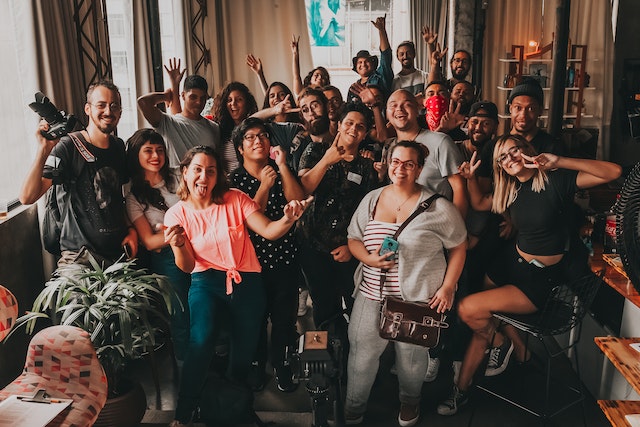
5 Ways To Boost Brand Awareness And Customer Engagement
Brand awareness and customer engagement are the cornerstones of business success.
Implement these five strategies, and you’ll create a robust brand presence, foster customer loyalty, and drive growth.
1. Personalize Customer Experiences
 Personalization is more than just addressing your customer by their first name; it’s about delivering tailored experiences that resonate. According to a May 2022 survey, 94% of responding customers stated that a positive customer service experience made them more likely to purchase again. So, how do you do it?
Personalization is more than just addressing your customer by their first name; it’s about delivering tailored experiences that resonate. According to a May 2022 survey, 94% of responding customers stated that a positive customer service experience made them more likely to purchase again. So, how do you do it?
Always thank your existing customers. A personalized thank-you note with some branded mugs can elevate customer satisfaction and loyalty. It’s an excellent place to start.
Next, you must collect data through customer surveys, feedback forms, and analytics tools. Use this data to segment your audience into different categories—such as new visitors, returning customers, or high-value clients.
Tailor your email campaigns, website content, and even your product recommendations based on these segments.
You can use machine learning algorithms to predict customer behavior and preferences, allowing for even more targeted personalization. Don’t underestimate the power of retargeting campaigns; they can remind customers of products they’ve viewed but haven’t purchased, increasing the likelihood of conversion.
Remember, always measure the effectiveness of your personalization strategies through key performance indicators like click-through rates, conversion rates, and customer lifetime value to continually refine your approach.
2. Leverage Your Social Media Platforms
 Social media is your brand’s stage. First, identify the platforms where your target audience is most active—be it Instagram for a younger demographic or LinkedIn for professionals.
Social media is your brand’s stage. First, identify the platforms where your target audience is most active—be it Instagram for a younger demographic or LinkedIn for professionals.
Develop a content calendar that aligns with key dates and events relevant to your audience. Use eye-catching visuals and compelling captions to grab attention. Don’t just use hashtags; create them.
A unique, brand-specific hashtag can become a rallying point for your community. Engage with your audience by responding to comments, sharing user-generated content, and running interactive polls or contests.
Platforms like Facebook and Instagram offer robust targeting options, allowing you to reach potential customers based on location, interests, and behavior.
3. Develop Compelling Content
 Your content should be an island of excellence in a sea of mediocrity. Start by identifying the pain points and interests of your target audience.
Your content should be an island of excellence in a sea of mediocrity. Start by identifying the pain points and interests of your target audience.
Develop content that addresses these issues in an informative and engaging manner. Use storytelling to make complex topics relatable. Use different formats—blogs, videos, podcasts—to reach a broader audience.
Remember to monetize your brand effectively. Always include a call-to-action that guides the reader on what to do next. Monitor your analytics to understand what’s working and refine your strategy accordingly.
And master SEO best practices to ensure your content ranks well on search engines. This includes keyword research, meta descriptions, and high-quality backlinks.
Finally, don’t underestimate the power of social proof. Featuring testimonials, case studies, or user-generated content can add credibility to your content and encourage more engagement.
4. Collaborate With Influencers
 Influencer marketing is not just about finding someone with a large following; it’s about finding effective outsourcing for your brand.
Influencer marketing is not just about finding someone with a large following; it’s about finding effective outsourcing for your brand.
Research potential influencers who align with your brand values and engage with an audience similar to yours. Start with a small collaboration, like a product review or a giveaway, to test the waters.
Set clear expectations and deliverables for both parties. Track the performance of these collaborations through metrics like engagement rate, reach, and ROI to gauge their effectiveness.
To maximize the impact of your influencer partnerships, consider long-term collaborations that go beyond a single post or campaign. This builds trust and familiarity among the influencer’s audience.
Also, leverage the content created during these collaborations across your own marketing channels—like social media, email newsletters, or your website. This not only extends the life of the content but also provides fresh material for your audience.
Always ensure that influencer collaborations adhere to legal guidelines and ethical standards, including proper disclosure and transparency, to maintain the trust and integrity of your brand.
5. Foster Community Engagement
 Build a community. Start by creating a dedicated space for your community, whether a Facebook group, a subreddit, or a forum on your website. Populate this space with valuable, exclusive content that can’t be found anywhere else.
Build a community. Start by creating a dedicated space for your community, whether a Facebook group, a subreddit, or a forum on your website. Populate this space with valuable, exclusive content that can’t be found anywhere else.
Encourage discussions by asking open-ended questions and spotlighting community members who provide valuable insights. Run regular events like AMAs (Ask Me Anything), webinars, or virtual meetups to keep the community engaged. Recognize and reward active members to encourage more participation.
To deepen the sense of community, consider creating a loyalty or rewards program that offers exclusive benefits to active members. This could include early access to new products, special discounts, or even branded merchandise.
Use community feedback as a valuable resource for product development or service improvements. Your community members are your most engaged customers, and their insights can be gold.
Don’t just manage your community—be an active participant. Your involvement sets the tone and encourages others to engage more deeply, turning a group of customers into a community of brand advocates.
Author Profile
- Blogger and Educator by Passion | Senior Online Media & PR Strategist at ClickDo Ltd. | Contributor to many Education, Business & Lifestyle Blogs in the United Kingdom & Germany | Summer Course Student at the London School of Journalism and Course Instructor at the SeekaHost University.
Latest entries
 Search Engine OptimizationMay 23, 2024The Dos and Don’ts of Local SEO
Search Engine OptimizationMay 23, 2024The Dos and Don’ts of Local SEO Digital MarketingMay 13, 2024How to use VIN Check Insights to Understand Consumer Behaviour in the Automotive Industry
Digital MarketingMay 13, 2024How to use VIN Check Insights to Understand Consumer Behaviour in the Automotive Industry Search Engine OptimizationApril 26, 20245 Best Ways to Learn SEO as a Beginner
Search Engine OptimizationApril 26, 20245 Best Ways to Learn SEO as a Beginner Digital MarketingApril 15, 2024The Pillars of Corporate Reputation Management in the Digital Age
Digital MarketingApril 15, 2024The Pillars of Corporate Reputation Management in the Digital Age

